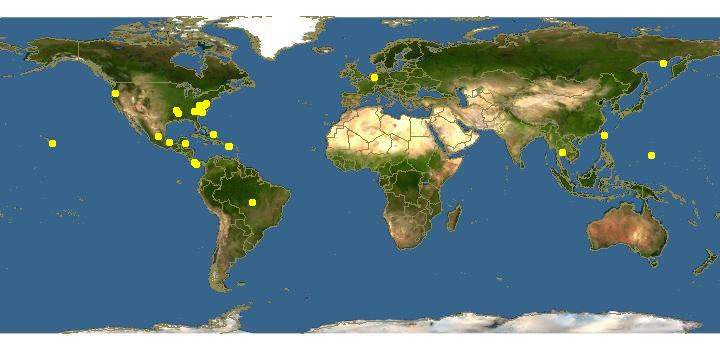
Click on map for details about points.
|
|
Overview | |
Cultivated on media such as 0.1 L-P (pH 6.0), 0.5G-0.1P, and hay infusion agars in association with Escherichia coli at 22-25 C. Sorocarps usually solitary, sometimes clustered, variable in length, up to 1.0 cm or more when incubated under overhead light, strongly phototropic and often much longer in unidirectional light, typically bearing branches in whorls, the number and dimensions of these varying with the strain and the culture environment. Sorophores weakly pigmented vinaceous or pale violet, commonly ranging from 15 to 40 Ám in diam. at the base and gradually narrowing to 8-10 Ám near the apex, bases slightly clavate, unexpanded or occasionally narrowed; whorls per sorocarp often 3-8, ranging from 1 to 10, occasionally more, evenly spaced or interrupted, sometimes ill-formed; branches per whorl commonly 2-5, rarely more, variable in length. Sori globose, vinaceous to pale violet, darkening in age and of two classes, terminal and lateral (on branches), the former commonly 100-200 Ám in diam., sometimes larger, the latter about 35-75 Ám as a rule. Spores narrowly elliptical, mostly 5-7 x 2.5-3.0 Ám but occasionally 8.0Ám in length, with clusters of polar granules usually prominent. Cell aggregations radiate in pattern, ranging from 2-3 mm in diam. to quite large with converging streams up to a centimeter in length, the larger aggregations subdividing into several parts with each producing one or more sorocarps. Vegetative myxamoebae irregular in form and variable in dimensions, commonly 15-20 x 10-15 Ám, showing filose pseudopods when actively moving. Macrocysts relatively rare, usually produced by pairs of compatible mating types, less commonly formed by self-compatible strains, commonly 25-60 Ám in diam.; microcysts not reported or observed.
|
|
|
Links to other sites | |
|
|
|
Acknowledgements | |
The Eumycetozoan Project -- working to understand the ecology, sytematics and evolution of myxomycetes, dictostelids and protostelids -- the true slime molds.
Sponsored by grants from the National Science Foundation.
|
|
|
Feedback |
Please send any corrections and comments about this page to John Shadwick
Department of Biological Sciences, University of Arkansas, Fayetteville, AR 72701, USA
email: jshadwi@uark.edu
phone: USA-479-575-7393.
|
|
| Supported by | |
Updated: 2024-05-09 01:26:22 gmt
|